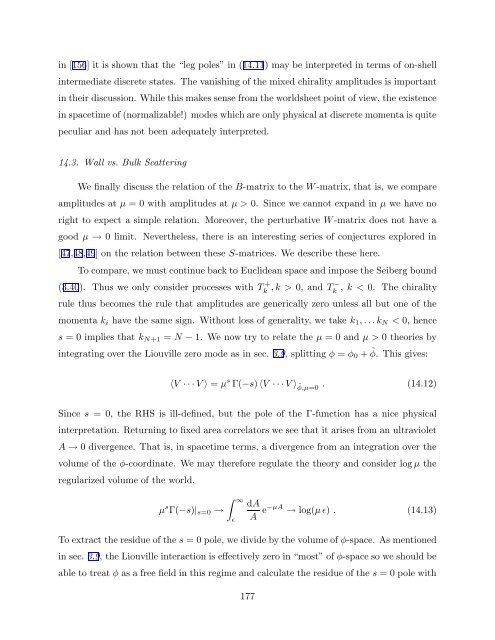arXiv:hep-th/9304011 v1 Apr 5 1993
arXiv:hep-th/9304011 v1 Apr 5 1993
arXiv:hep-th/9304011 v1 Apr 5 1993
Create successful ePaper yourself
Turn your PDF publications into a flip-book with our unique Google optimized e-Paper software.
in [156] it is shown <strong>th</strong>at <strong>th</strong>e “leg poles” in (14.11) may be interpreted in terms of on-shell<br />
intermediate discrete states. The vanishing of <strong>th</strong>e mixed chirality amplitudes is important<br />
in <strong>th</strong>eir discussion. While <strong>th</strong>is makes sense from <strong>th</strong>e worldsheet point of view, <strong>th</strong>e existence<br />
in spacetime of (normalizable!) modes which are only physical at discrete momenta is quite<br />
peculiar and has not been adequately interpreted.<br />
14.3. Wall vs. Bulk Scattering<br />
We finally discuss <strong>th</strong>e relation of <strong>th</strong>e B-matrix to <strong>th</strong>e W -matrix, <strong>th</strong>at is, we compare<br />
amplitudes at µ = 0 wi<strong>th</strong> amplitudes at µ > 0. Since we cannot expand in µ we have no<br />
right to expect a simple relation. Moreover, <strong>th</strong>e perturbative W -matrix does not have a<br />
good µ → 0 limit. Never<strong>th</strong>eless, <strong>th</strong>ere is an interesting series of conjectures explored in<br />
[47,48,49] on <strong>th</strong>e relation between <strong>th</strong>ese S-matrices. We describe <strong>th</strong>ese here.<br />
To compare, we must continue back to Euclidean space and impose <strong>th</strong>e Seiberg bound<br />
(3.40). Thus we only consider processes wi<strong>th</strong> T + k , k > 0, and T − k<br />
, k < 0. The chirality<br />
rule <strong>th</strong>us becomes <strong>th</strong>e rule <strong>th</strong>at amplitudes are generically zero unless all but one of <strong>th</strong>e<br />
momenta k i have <strong>th</strong>e same sign. Wi<strong>th</strong>out loss of generality, we take k 1 , . . . k N < 0, hence<br />
s = 0 implies <strong>th</strong>at k N+1 = N − 1. We now try to relate <strong>th</strong>e µ = 0 and µ > 0 <strong>th</strong>eories by<br />
integrating over <strong>th</strong>e Liouville zero mode as in sec. 3.9, splitting φ = φ 0 + ˜φ. This gives:<br />
〈V · · · V 〉 = µ s Γ(−s) 〈V · · · V 〉 ˜φ,µ=0<br />
. (14.12)<br />
Since s = 0, <strong>th</strong>e RHS is ill-defined, but <strong>th</strong>e pole of <strong>th</strong>e Γ-function has a nice physical<br />
interpretation. Returning to fixed area correlators we see <strong>th</strong>at it arises from an ultraviolet<br />
A → 0 divergence. That is, in spacetime terms, a divergence from an integration over <strong>th</strong>e<br />
volume of <strong>th</strong>e φ-coordinate. We may <strong>th</strong>erefore regulate <strong>th</strong>e <strong>th</strong>eory and consider log µ <strong>th</strong>e<br />
regularized volume of <strong>th</strong>e world,<br />
µ s Γ(−s)| s=0 →<br />
∫ ∞<br />
ɛ<br />
dA<br />
A e−µA → log(µ ɛ) . (14.13)<br />
To extract <strong>th</strong>e residue of <strong>th</strong>e s = 0 pole, we divide by <strong>th</strong>e volume of φ-space. As mentioned<br />
in sec. 3.9, <strong>th</strong>e Liouville interaction is effectively zero in “most” of φ-space so we should be<br />
able to treat φ as a free field in <strong>th</strong>is regime and calculate <strong>th</strong>e residue of <strong>th</strong>e s = 0 pole wi<strong>th</strong><br />
177
















